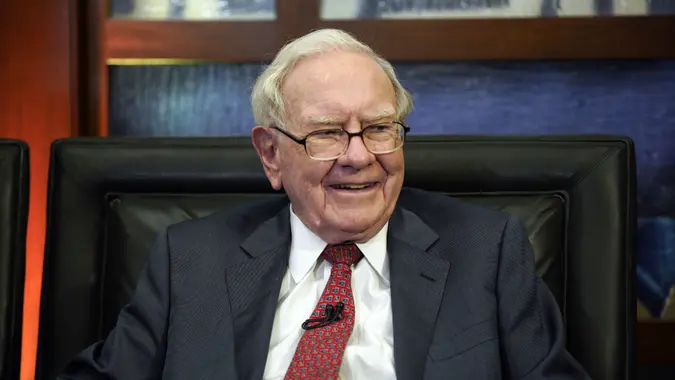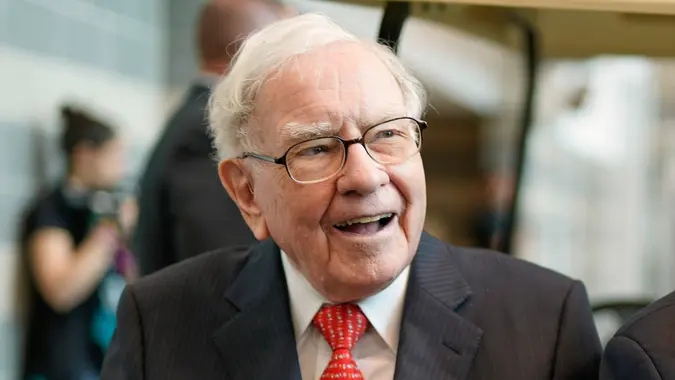How to Trade Forex: A Simple Beginner’s Guide

Commitment to Our Readers
GOBankingRates' editorial team is committed to bringing you unbiased reviews and information. We use data-driven methodologies to evaluate financial products and services - our reviews and ratings are not influenced by advertisers. You can read more about our editorial guidelines and our products and services review methodology.

20 Years
Helping You Live Richer

Reviewed
by Experts

Trusted by
Millions of Readers
Forex (foreign exchange) trading can seem intimidating at first, but it’s actually one of the most accessible ways to get started with investing. If you’ve ever asked yourself how to trade forex but felt overwhelmed by charts, jargon or fast-moving markets — you’re not alone.
What Is Forex Trading?
At its core, forex trading is the process of exchanging one currency for another to profit from price changes. You’re always trading in pairs, like USD/EUR or GBP/JPY.
Here’s how it works:
- You buy one currency (like the euro)
- You sell another currency (like the U.S. dollar)
- If the exchange rate moves in your favor, you make a profit
The forex market handles over $7.5 trillion in trades every single day, making it the largest financial market in the world. People trade forex for lots of reasons — speculation, hedging or diversifying beyond stocks. It’s popular because it’s open 24 hours a day, five days a week and allows traders to start with small accounts.
Is Forex Trading Right for You?
Learning how to trade forex takes time, but with the right approach, it can be a powerful addition to your investing toolkit.
It’s great for people who:
- Enjoy learning about global economics
- Want to trade outside traditional stock markets
- Are disciplined with risk and money management
How Forex Trading Works
Understanding how forex trading works before you make your first trade can help you avoid making expensive mistakes.
Understanding Currency Pairs
Each forex trade involves two currencies:
- Base currency (first in the pair)
- Quote currency (second in the pair)
Example: In EUR/USD, you’re buying euros (base) and selling U.S. dollars (quote). If the exchange rate goes up, your euros are worth more in dollars.
There are three types of pairs:
- Major pairs: Include the U.S. dollar and other large economies (e.g., EUR/USD). The seven most common pairs, each of which includes the U.S. dollar and another major currency, like the euro, British pound sterling, Japanese yen, Swiss franc or Canadian, Australian or New Zealand dollar.
- Minor pairs: Don’t include the dollar but involve major currencies (e.g., EUR/GBP)
- Exotic pairs: Mix one major currency with one from a developing country (e.g., USD/TRY). These pairs are the riskiest to trade because developing currencies tend to be more volatile.
Depending on the trading platform you use, you could have a choice of dozens of different currency pairs available for trading.
How Forex Prices Move
Exchange rates are in constant flux due to a variety of factors, including:
- Demand for a particular currency
- Inflation and other economic conditions
- Monetary policies, including changes to federal interest rates, implemented by central banks
- Market sentiment
Price changes are measured in pips, usually 0.0001 of a currency’s value. The spread is the difference between the buy and sell price — think of it as the broker’s cut.
Pro tip: Major pairs have tighter spreads, making them cheaper to trade than exotic ones.
How to Start Trading Forex
Starting is easier than you might think. Here’s how to trade forex in four straightforward steps.
1. Choose a Trusted Forex Broker
Look for brokers regulated by the Commodity Futures Trading Commission (CFTC) or National Futures Association (NFA). Consider platforms like:
- MetaTrader 4/5
- thinkorswim by Charles Schwab
- Interactive Brokers FXTrader
2. Open and Fund Your Account
You’ll provide basic info, upload ID verification and connect a funding source (like your bank account). Keep in mind, the exact process for opening and funding an account differs from one brokerage to the next.
3. Use a Demo Account First
Most brokers have extensive educational material on their websites to help novice traders learn the ropes. But the best resource might be paper trading tools that let you experiment with trading without risking any real money.
Most brokers offer demo accounts where you can trade with virtual money. It’s the best way to test strategies with zero risk.
4. Start Trading With Real Money
Once you’re comfortable, start small and stick to your plan. Remember: only trade what you can afford to lose.
Popular Forex Trading Strategies
Let’s look at three beginner-friendly strategies:
Day Trading
Buy and sell within the same day. Quick in, quick out. Perfect if you enjoy fast-paced decision-making. It’s the same strategy you’ve might’ve heard of as it relates to stock trading and it requires that you watch the charts and be ready to move quickly when the conditions are right.
Swing Trading
Hold positions for days or even weeks. Ideal for traders who spot trends and don’t want to monitor trades all day. It involves watching larger trends for brief opportunities to earn profits.
Scalping
Make dozens (or even hundreds) of quick trades throughout the day to profit from tiny price moves. Whereas day trading focuses more on individual pairs and their movements through the day, scalping is a bombardment of trades where you might open and close positions in seconds or minutes. High skill and focus are required.
How To Read Forex Charts
Understanding charts helps you know when to enter and exit a trade.
Candlestick Charts
These show price movements in “candles.” Green candles mean the price increased; red candles mean it fell. A short or missing wick on a green candlestick means buyers were in control. A short or missing wick on a red candlestick means sellers were in control. A long wick means both were in control.
Support and Resistance
These are key price levels where the market tends to pause or reverse:
- Support: Price floor
- Resistance: Price ceiling
When you’re looking at a chart for a particular period, imagine the support level as a line that spans the chart at the point of the lowest prices, and imagine the resistance level as a line that spans the chart at the peaks in price. You’ll see that the lines represent a floor and a ceiling in the price movement.
Technical Indicators
Use tools like:
- Moving Averages to smooth price trends
- MACD to spot momentum
- RSI to see if a currency is overbought or oversold
Managing Risk in Forex Trading
Risk is part of forex, but it can be managed. Here’s how:
- Stop-loss orders: Automatically close trades at a set loss level
- Take-profit orders: Lock in profits once a target is hit
- Position sizing: Risk only 1 to 2% of your account per trade
- Avoid over-leveraging: Leverage boosts gains and losses. Be cautious.
According to ESMA data, over 70% of forex traders lose money in their first year. Risk management is not optional.
Managing Risk in Forex Trading
Forex trading is extraordinarily risky. A DailyForex survey of international forex traders found that the overwhelming majority are unsuccessful. Among those who were successful, most had been trading for more than four years. While those statistics drive home the fact that your chances of making money with forex trading are low, you can take steps to mitigate the risk.
- Stop-loss orders: A stop-loss order lets you specify the biggest loss you’re willing to take. Once your loss reaches that level, the platform automatically tries to sell your position to prevent additional losses.
- Take-profit orders: You can use a take-profit order to automatically sell when your profit reaches a specific amount. Rather than try to wring every cent you can out of a trade and risk an unexpected reversal, you quit while you’re ahead.
- Position sizing: Keep each trade relatively small with your total bankroll. Even the best traders are going to be wrong much of the time, so if you’re going to trade forex for a living, you have to give yourself the room to make mistakes without wiping out your resources.
- Avoid over-leveraging: Leveraging uses borrowed funds to increase how much you can invest. The danger is the potential for disproportionate losses — you can lose far more than you borrowed.
Common Forex Trading Mistakes to Avoid
- Trading without a plan – Have a clear goal, entry/exit rules and budget.
- Letting emotions take over – Stick to logic, not fear or greed.
- Ignoring risk – One bad trade without a stop-loss can ruin your entire account.
Final Take to GO: Ready to Start Trading Forex?
Forex trading can feel overwhelming at first, but once you understand the basics, choose the right tools and stick to a strategy, it becomes much more manageable.
If you’re ready to take the next step, start by exploring our day trading beginner’s guide or reviewing our top-rated brokers for beginners. Want to keep building your skills? Check out our Beginner’s Guide to Stock Trading or learn about some investment mistakes to avoid.
Start small, stay curious and remember — successful trading is a marathon, not a sprint.
FAQ
- How much do I need to start trading forex?
- Some brokers let you start with as little as $100, but $1,000+ is more realistic for testing strategies.
- Is forex trading risky?
- Yes. It’s volatile and fast-paced. Education and risk management are key.
- Can I trade without experience?
- Yes—but it’s not smart. Always use a demo account first.
- When’s the best time to trade forex?
- During session overlaps (like London/New York) when trading volume is high and price moves are strongest.
John Csiszar contributed to the reporting for this article.
Data is accurate as of July 14, 2025, and is subject to change.
Editorial Note: This content is not provided by any entity covered in this article. Any opinions, analyses, reviews, ratings or recommendations expressed in this article are those of the author alone and have not been reviewed, approved or otherwise endorsed by any entity named in this article.
Our in-house research team and on-site financial experts work together to create content that’s accurate, impartial, and up to date. We fact-check every single statistic, quote and fact using trusted primary resources to make sure the information we provide is correct. You can learn more about GOBankingRates’ processes and standards in our editorial policy.
- TD Ameritrade "Learn how to trade forex and unleash a world of potential opportunity."
- Forbes "A Basic Guide To Forex Trading."
- The Bank for International Settlements (BIS) "OTC foreign exchange turnover in April 2022"
- Fidelity "Support and resistance"
- European Securities and Markets Authority "Notice of ESMA’s Product Intervention Renewal Decision in relation to contracts for differences "
 Written by
Written by  Edited by
Edited by 

























